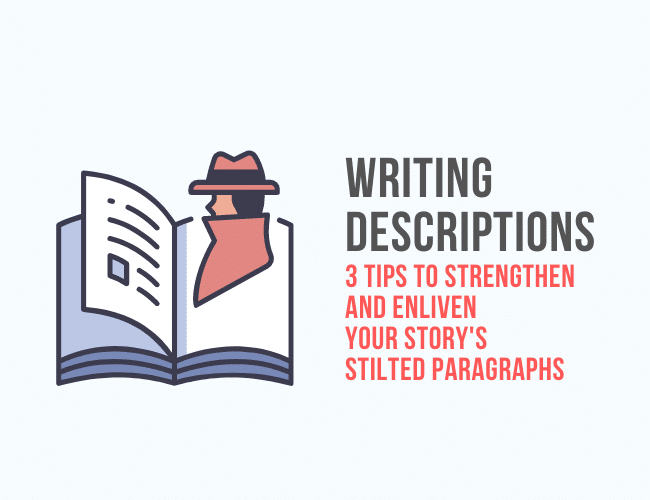Do you find that the beautiful story in your head doesn’t always come out the way you want? Are your unique characters dragged down by a list of stilted writing descriptions?

Maybe they sound something like this:
He saw her across the room. Her hair was honey brown and her lips were red. She wore a tight black dress and her shoes were expensive. She smoked a cigarette and blew smoke rings while leaning on the bar and drinking a gin and tonic. He usually wasn’t into women who smoked, but she was hard to resist.
After you write a description like this, you might think it sounds fine. It works. You can imagine what the protagonist sees, and yet something feels stiff. And because of this, you're looking for ways to enliven your writing descriptions. Here are a few simple tricks.
Vary Sentence Structure to Avoid a Monotonous Tone
A common mistake beginner writers make is writing description that follows the same sentence structure. This creates a never-ending sequence of noun-verb-description, noun-verb-description that can hinder your voice and style.
Just take a look at the sentence used in the example above. Notice how almost all of the sentences in the paragraph begin with “He” or “She” followed by a verb. Not only does this stifle the writing description's imagery, it’s boring.
It needs some structure-switch-up!
By varying the length and structure of your sentences, alternating between long and short sentences, simple and complex, you can create a more engaging rhythm in your writing descriptions.
The trick here is that by varying your sentence structure, you can make the passage sound like music. Instead of stringing together lines that create a monotonous tone, varying structure creates a far more melodic (and pleasant) paragraph.
Take this, for instance:
He saw her across the room. Her hair was honey brown and her lips were red. She wore a tight black dress and her shoes were expensive.
With varied sentence structure, it becomes this:
From across the room, she caught his eye. He blinked once, and then felt his feet glide towards hers like a moth sucked up by a flame. A rush of honey brown hair tumbled down her shoulders, draping over the black Fendi dress that clung to her like a second skin.
Use Vivid Writing Descriptions That Focus on Verbs
Memorable moments in stories need more than descriptions flavored with shapes and colors. Passages need comparisons, emotions, actions, and reactions that differentiate how bystanders react when they comment about Harry Potter's green eyes (that look like his mother's)—and how that response affects Harry.
A simple rule of thumb that strengthens writing descriptions is that verbs are far more powerful and memorable than adjectives or adverbs. Period.
When a writer's concentration is placed on verbs, they naturally trigger a reader's senses. For instance, you might change:
She smoked a cigarette and blew smoke rings while leaning on the bar and drinking a gin and tonic.
Instead of telling the reader about the cigarette being smoked, verbs can tickle one or more of the senses while describing the same action.
Focusing on verbs could make the above something more memorable, like this:
He watched her slide a cigarette out of her mouth and a thick smoke ring steamed from her lips. The bartender slid her a gin and tonic—same as his father used to drink. Warm and acidic, with hints of pine that always intrigued him until he tasted it.
Remember that rule of show, don't tell?
Writing descriptions that focus on verbs instead of adjectives do exactly that—show the reader something more than flat, visual descriptions. Just make sure to change up your writing descriptions, since this will also aid your sentence structure variance.
For more on how to use effective verb descriptions, see How to Use Vivid Verbs to Bring Your Scenes to Life.
Add Perspective to Personalize the Scene
Every person looks at something differently.
A Golden Delicious apple can tantalize one person and disgust another. Heather Mills next door might look at it and think about how it’s going to taste in an apple-cranberry pie whereas Hunter Smith considers how it would do as a replacement bowling ball in a game of kitchen bowling.
Perspective tells a lot about the person viewing the subject being described, which adds another layer of complexity to the description itself.
Let's look back at the opening example.
In this paragraph, the narrator usually isn't “into women who smoked, but she was hard to resist.” To emphasize this further, we could examine why he wasn't usually into women or how he couldn't resist her (more on how to revise using this tip below).
To learn more about how to write with perspective, see Two Steps to Fix Flat Characters Using Voice and Personality.
Put It All Together
When you find your story becomes stiff, it’s possible your words aren't communicating your intent with the best writing descriptions. Knowing this is important.
A light and funny scene will read much differently than something dark and moody. Not knowing this will probably create a paragraph bogged down by ambiguous, unmemorable, or redundant descriptions.
I've noticed this in my own writing when revisiting drafts for revisions. Using the tips mentioned in this post have helped me clean up my writing descriptions that don't work for ones that enliven my story with unique details.
Revisiting my example at the beginning of this post is proof. Here's how I've revised it in a few different ways. (Review the example in the opening paragraph for a closer look at the exact differences.)
Example One: Uses Complex Sentences and Vivid Descriptions
From across the room, she caught his eye. He blinked once, and then felt his feet glide towards hers like a moth sucked up by a flame. A tumble of honey brown hair draped down her shoulders, similar to how the black Fendi dress clung to her chest and back like a second skin. He watched her slide a lit cigarette out of her mouth and a delicate smoke ring rose from her lips.
The bartender slid her a gin and tonic—same as his father used to drink. Warm and acidic, with hints of pine that always intrigued him until he tasted it. He had no doubt she would kiss like a sailor and taste like an ashtray.
And yet, he thought, maybe she would be worth it.
Example Two: Uses Short, Simple Sentences and Basic Visual Descriptions
Tight dress. Red lips.
He downed another drink. On most days he preferred blondes, but there was something special about this brunette. He watched her. Long painted fingers traced the rim of a gin and tonic. A half-smoked, lipstick-stained cigarette dangled out of her mouth. She would be hard. She would be dirty. She looked like tomorrow morning’s mistake. But tonight, she was perfect.
Bring Your Writing to Life
By varying sentence structure and making use of verbs and perspective, the passages above not only become more interesting than the original version, but more fluid and pleasing to the reader's ear—and other senses.
Both ways improve the original with two different goals. The first is more complex and descriptive-heavy; the second is driven by shorter and more direct writing descriptions to present a somewhat sloppy exterior.
Keep in mind that neither is better than the other, because how you write your passage depends on what you want to communicate to the reader. Regardless of which you prefer, they’re both better than the paragraph without revisions.
Overall, fluid writing is simply a matter of writing with a goal in mind (how do you want this scene to come off to the reader?) and adjusting the writing description so that it contains different sentence structures, a variety of verbs, and a clear perspective.
With practice, you’ll find that your stilted writing can come to life in no time at all.
What’s the biggest issue you face with writing descriptions? Share in the comments section.
PRACTICE
Write a scene based on one of the following prompts (or come up with one of your own):
- A student walks into a new classroom on their first day of school
- A person meets a blind date for the first time
- A grandparent meets their new grandchild for the first time
Take fifteen minutes to write and focus on writing vivid descriptions through sentence structure, verb usage, and perspective. Don't forget to share your passages in the comments below for feedback!







0 Comments